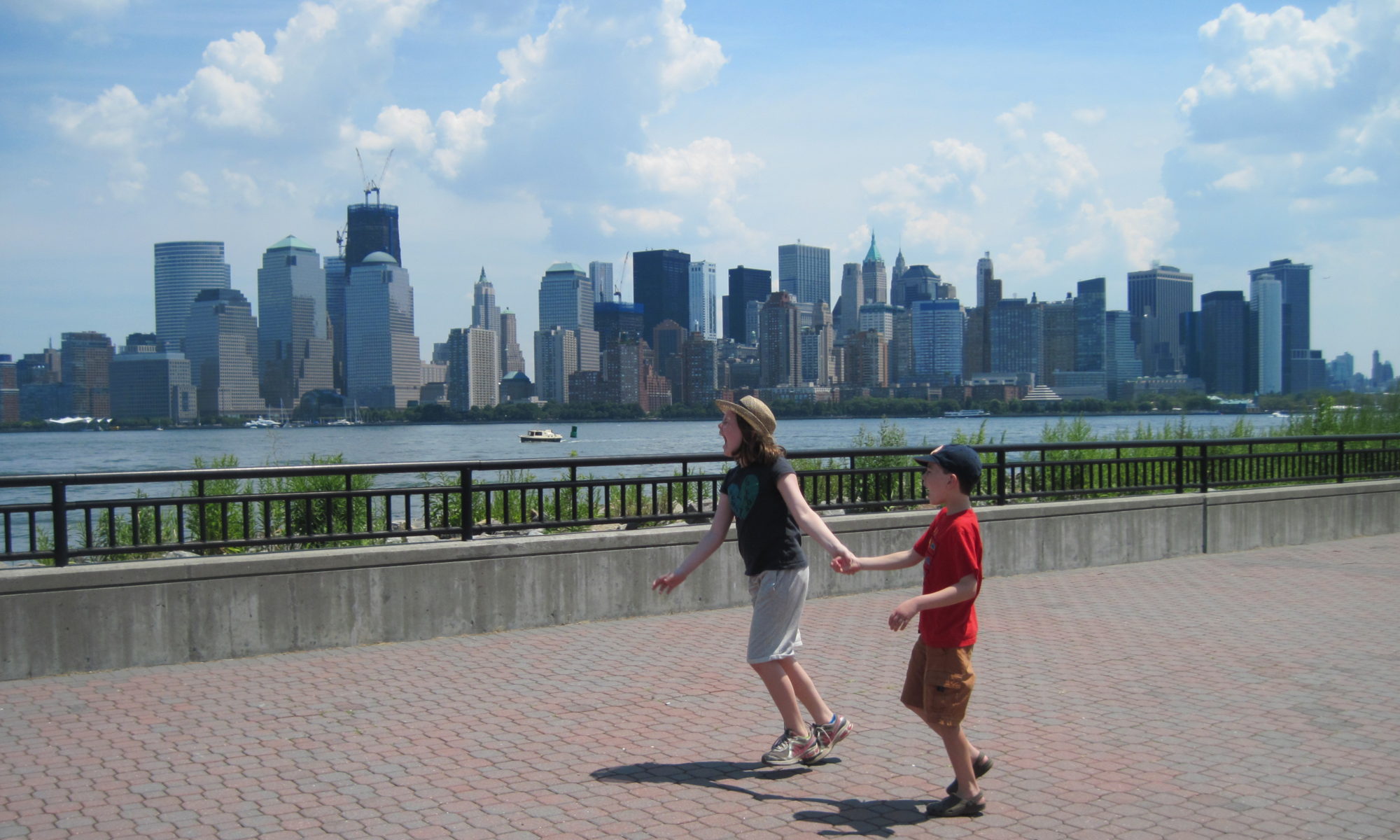I saw the King Tut exhibit in the 1970s, traveling from Arizona to San Francisco just for the occasion. That exhibit brought 50 of King Tut’s tomb items around the country, causing mob scenes (well, a lot of people anyway) in the form of record attendance. I saw a fair amount of Tut goods in Cairo’s Egyptian Museum when traveling there in 1995. And then when another Tut exhibit came through in 2010 (with 50 moretomb items), and I saw it again in San Francisco AND New York (the advantage to living in both places during their run). Read more about that King Tut exhibit here.
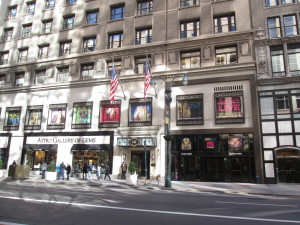
So when I heard that King Tut was back in the Big Apple, with a new kind of exhibition, of course I jumped on the opportunity. I went for a press preview of the Discovery of King Tut, and then took the family back this past weekend. The big difference between the exhibits is that this exhibition focuses on the discovery of Tut’s tomb, and displays only replicas (more than 1,000 of them, versus the 50 genuine artifacts brought over previously). While it sounds a little disappointing that they’re reproductions, rest assured, you will not feel cheated. Here’s my review – King Tut exhibition with kids.
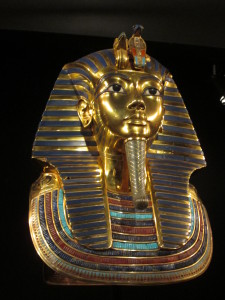
Since the exhibit is about the discovery of the tomb, you’ll start out watching a movie about Howard Carter, the archaeologist who found it. There’s a lesson in persistence here, as he was one of the few believers that Tut’s tomb was in the Valley of the Kings, an area which was thought to be completely dug-up already. Carter’s crew of around 100 dug for six winters without finding the tomb. starting in 1917, and patron Lord Carnarvon (namesake family from Downton Abbey’s house) was running out of money. When Carter found the tomb entrance and intact seal in 1922, he waited 2 weeks for Carnarvon to arrive for the opening.
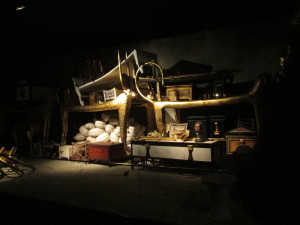
[ad name=”Google Adsense-1″]
What they found when opening the antechamber (reproduction above – in situ) was several beds, as well as egg-shaped containers that had food for the afterlife. Not seen in this photo are chariot parts that are upended, Tut’s thrones and two statues guarding the entrance to the burial tomb. And of course a bunch of other things, made of gold, alabaster and other precious materials. The room looks like a garage or attic, and this was mostly the way it was left by those who buried Tut, not surprising given that more than 700 objects were found in the antechamber. There were two grave robbers (more later) but they just carried out some jewelry and small items. It’s not thought that they made the room as messy looking as it was.
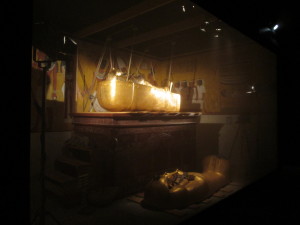
What you’ll see in the exhibition’s first rooms are the in-situ reproductions of what Carter saw after breaking through the wall. The antechamber and treasury rooms are created as exact replicas. You’ll also see the reproduced stone sarcophagus and gold coffin nearby with painted walls, and a screen covering the room to show a movie that has photos of the uncovering.
A note that if you want to take photographs of these rooms, do it when the light is on (the light moves between different parts of the room and never fully illuminates the entire room). The light is coordinated with the headsets/listening devices and does not come back on when you’ve completed the explanation for that area. You’re not allowed to take flash pictures, but non-flash ones are fine.
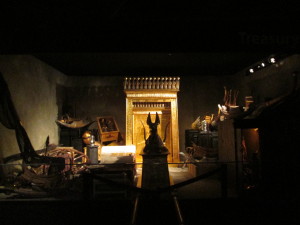
You’ll see many of the items in the in-situ rooms later in the exhibition as well. Above, in the treasury, is the guardian Anubis (the dog statue), guarding the golden shrine that has the canopic jars inside. More on them later. Around the corner from these rooms is the largest golden shrine (below), which was seen initially when Carter and the other first viewers entered the burial chamber. When Carter broke through the burial chamber wall, he had to do so very carefully to avoid any pieces from falling inside and damaging the shrine. He could tell from the first pass of a candle in the room that it was a gold wall.
The replicas are impressive, and sanctioned by the Egyptian Antiquities department. They were made by local Egyptian artisans. At the press preview, I heard from Dr. David Silverman, an Egyptology professor who curated the two prior Tut exhibits and is the curator of the Egyptian section at the Penn Museum (based at my alma mater, University of Pennsylvania). And he got his BA from Rutgers, so he can’t be all bad! Dr. Silverman pointed out that the replicas are precise,even copying the artistic differences, since several artists were involved with larger items like the golden shrines.
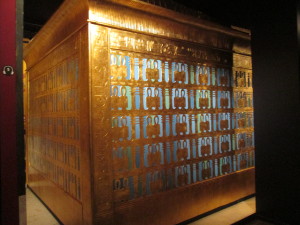
The shrine you see above look almost modern in its appearance. Those colorful panels were made of faience, and the box is wood (originally probably oak, maybe imported from Syria), covered by plaster and then gold plating. It’s hard to get an understanding of the enormity of this box, but it was huge – 17 feet long, 11 feet wide and 9 feet high. The explorers only had about two feet between the shrine and the burial chamber walls and the top of the shrine was close to the ceiling. They also had to move some alabaster vases in the corners to make their way around. The walls were covered with paintings, and the floor was four feet lower than the antechamber floor. The treasury could be accessed from the far side, the side where the shrine’s doors were.
Carter opened the doors to this shrine and found another shrine inside, which was bolted and sealed. Below you can see what the inside of the largest shrine looked like, as well as a drawing on the floor of where the other shrines, three coffins and mummy fit into. Carter was previously an artist, and his extensive drawings were helpful in preserving the information about Tut’s tomb. The back of the shrine has a relief of a cow – can you see it?
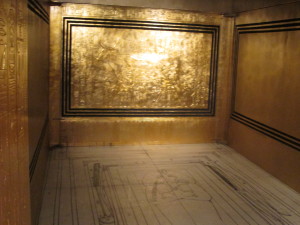
Inside this shrine were three additional golden shrines, plus the sarcophagus, a gold covered golden coffin, a decorated coffin, and a solid gold coffin holding the mummy (that one was around 240 pounds empty). You can see two of the shrines downstairs, and an additional one is inside the second smallest one. I wondered how they got the shrine in there, if there was so little room to move. Turns out they got it in the same way that Carter and his colleagues removed it. The shrines broke down into 80 pieces and they were carried away piece by piece. It took 84 days to move the shrines out.
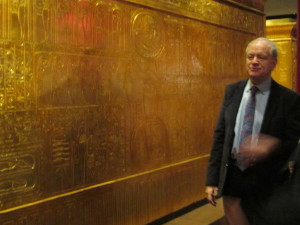
Dr. Silverman showed us how Egyptians read heiroglyphics. Look at the way the Egyptian people are facing, and then read it that way. So if the people are facing left, you read right to left, the way they’re looking/facing. He pointed out some differences in the art work on the shrine above, showing how it was done by two different artists. He said that the original looks the same way. You can read heiroglyphs left to right too, and sometimes bottom to top. Ironically, Dr. Silverman said that when he gives lectures, the two songs that usually play during the introduction are the Saturday Night Live’s King Tut, and Walk Like an Egyptian. The SNL costume can be seen at the Saturday Night Live exhibition in the same building! (See my review). That King Tut song sold a million copies!
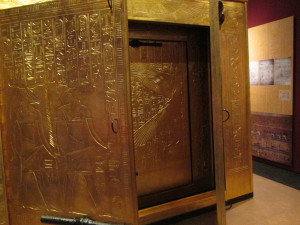
The two smallest shrines can be seen above. The mummy had desiccated flowers on it, which Dr. Phyllis Saretta said were analyzed and they could figure out the season of death because of when these flowers bloomed. Dr. Saretta is also an Egyptologist, and used to work at the Metropolitan Museum of Art (she still lectures there). We had a chance to chat at the exhibit.
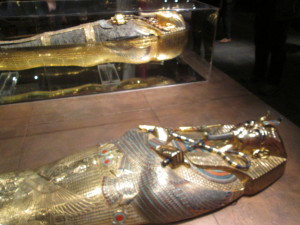
The linen covering Tut’s body was black and sticky from the perfumed resin used. When the archaeologists tried to remove the linen, they ended up breaking the body into several pieces! Tut was stuck to the gold coffin.
You probably recognize the gold mask at the top of this post. That was the 25 pound gold mask covering King Tut’s face in the coffin. You’ll see a lot of jewelry in the exhibit, but it’s only 20-40% of the jewelry that was originally in the tomb. Robbers broke in soon after the burial, and removed most of the jewelry in the antechamber, as well as the costly perfumes and oils (of the 50 or so vessels found in the tomb, only one or two had any residue). The robbers carried the jewelry out tied onto cloth strips and hung around their waist. They were later caught and put on trial. The jewelry you see in the exhibit was actually on the mummy, which is why is wasn’t stolen. It would be too hard to have broken into the shrines to get into the tomb. The exhibit shows some of the 150 jewelry pieces and amulets which laid on the mummy inside the coffin. 150 pieces! They were generally tied on with a linen cloth in a particular order.
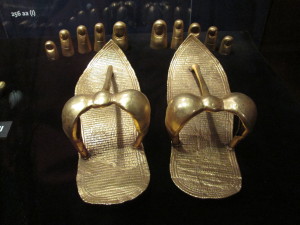
Below are reproductions of the canopic jars and their shrine. These jars held the dried out organs that the Egyptians thought would be necessary in the afterlife, (I got different stories from different sources about which organs they saved, but it was some combination of liver, kidneys, spleen, stomach, intestines and lungs). Interestingly, the heart is buried in the body, and the brain is pulled out and the cavity stuffed. No need for the brain in the afterlife!
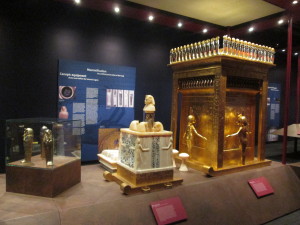
Dr. Saretta said that when the Met had the Tut artifact tour, the museum gift shop sold copies of the golden shrine above. And it was really popular! I’m having a hard time picturing people leaving the gift shop with that shrine, as it’s large. She also said that before the tomb was discovered, people found the remains of Tut’s burial funeral meal the priests ate. Usually this meal was eaten in the tomb, but for some reason this was located away from the tomb. They could analyze the food and bones to see what they ate. If you want a chance to hear more about Tut, the exhibition is presenting Tut Talks on some Friday nights in December and January. You can hear lectures from world-renown Egyptologists and get tours as well.
I asked Dr. Saretta what she thought of the exhibit, thinking maybe she would poo-poo the replicas. Instead she said how amazed she was, and what a great job they did. She loved seeing so many of Tut’s funerary items in one place, like they brought everything together in a way you can’t actually do in real life. Most of the Tut items will never leave Egypt. She thought it would be a great exhibit for kids, because even though they shouldn’t go touching everything, it’s not like they’d be touching items from 3,000 years ago. If they touched the shrines (which we did upstairs), you won’t get in trouble.
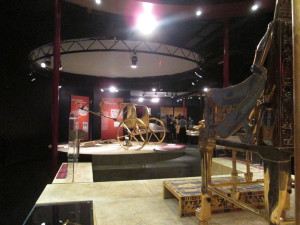
The last room had one of the parade/ceremonial chariots set up, as well as his golden throne. You’ll also see some model ships he could use in the afterlife, and a lot of statues found in the tomb. Upon exiting, there’s a room with colorized photos from the times of discovery. They’re incredible photos and it’s nice to see them displayed next to the black and white versions.
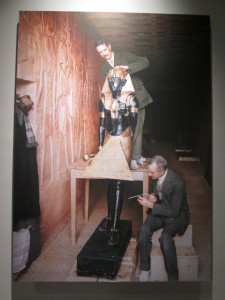
What did the kids think?
If you’re taking the kids, it’s a good idea to have them do some research ahead of time. There’s a lot of information at the exhibit, but coming in primed will help. The Tut exhibition website is excellent, and has videos and background information. My high school age daughter loved it. She really appreciated seeing the shrines and how large they were, and the movies and audio brought everything together. She liked hearing about the discovery process.
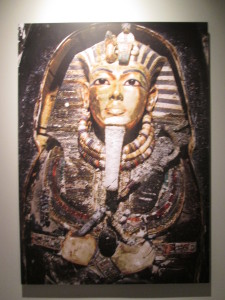
Where: Premier Exhibitions on 5th Avenue between 37th and 38th Streets. This is a new exhibition center, diagonal from Lord & Taylor (see their holiday windows here).
When: November 21, 2015 through May 1, 2016. Times vary – check the website.
Tickets: $29/adult, $20/child, $24/senior. You can get a combo ticket with Saturday Night Live Exhibition for $43.50/adult, $30/child, $36/senior. I’d recommend seeing Tut first if you go this route, as SNL is much more light-hearted, and it might be hard to go from there into the Tut exhibit.
Discount King Tut exhibition tickets: I found a $5 off coupon here or use promo code GUIDE when ordering online.
Audio tours: Audio tours are included. In the beginning, you’ll listen to the audio tour for the in-situ rooms and movie. Then you an enter the numbers to hear about the items of interest. There are plenty of drawings and photos on the walls, in addition to text. The audio tour uses a lot of Carter’s diary entries, which adds to the experience. There’s a children’s audio tour for kids up to age 12. Unfortunately when I went to the exhibit with my family, the audio and the movie were not synced up, and the movie started about 90 seconds after the audio. Since the audio is so helpful when looking in the first rooms as well (the lighting of the antechamber, treasury and burial room is coordinated with the audio), it was confusing to follow. Hopefully they get that fixed. It worked well during the press tour, and I could appreciate the difference.
Timing: The exhibition recommends you plan on spending two hours there. I spent 90 minutes by myself and about an hour with my family, who is not as into listening to audio tours.
Photos: At the end, you can get photos taken in front of a green screen, and have your face put into a Tut-like head covering, or get a hologram of you as a mummy. These are $20 each.
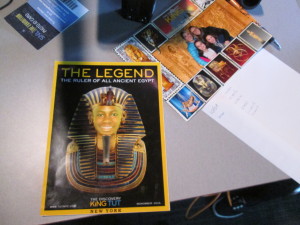

Disclosure: We received media tickets to review the exhibition.
